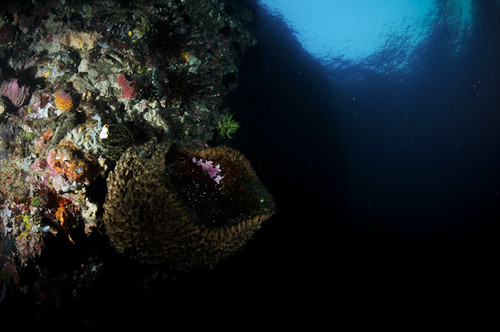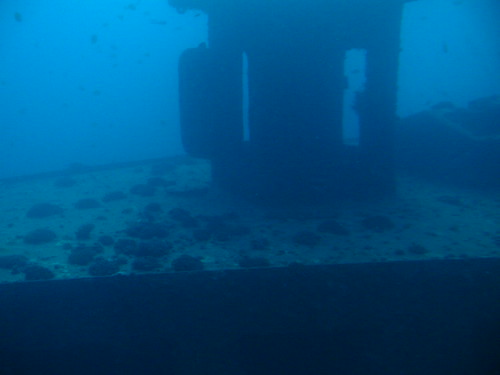The Belize Barrier Reef is the longest barrier reef in the Western Hemisphere and the second longest in the world. It is a series of coral reefs straddling the coast of Belize, roughly 300 meters offshore in the north and 40 kilometers in the south within the country limits. The Belize Barrier Reef is a 300 kilometers long section of the 900 kilometers long Mesoamerican Barrier Reef System, which is continuous from Cancún on the northeast tip of the Yucatán Peninsula through the Riviera Maya up to offshore Guatemala, making it the second largest coral reef system in the world after the Great Barrier Reef in Australia, popular for scuba diving and snorkeling. It is Belize's top tourist destination, attracting almost half of its 260,000 visitors, and vital to its fishing industry.
The three Belize atoll reefs are formed on two tiers of submarine ridges: Turneffe and Glover's on one ridge and Lighthouse on a separate ridge farther to the east. This accounts for their similar outlines and NE-SW orientations. Deep marine trenches separate the two ridges.
Inside the reef the water is shallow, with a blue tinge; outside the reef the water is deep and from the air shows a dark royal blue. On very clear days the reef appears as a narrow yellow line dividing the two shades of blue. Only near Ambergris Caye does the reef run so close to a well-populated caye. Here it is an almost so!id wall of magnificent coral formation broken only by narrow channels called "quebradas". Here an observant diver can be kept entertained for hours on end by the unending variety, shapes and colours ofthe tropical coral.
But the reef is more than just a decorative sideshow. Without it the island would not exist for it serves as a natural break-water protecting the beach from erosion by the waves, and sheltering the caye and its inhabitants. The remarkably clear and shallow water inside the reef allows excellent viewing of the fabulous marine life of the area. Rainbow tinged tropical fish, delicate sea fans and majestic coral gardens abound. Outside the reef, the seabed drops sharply in a series of plateau to depths of thousands of feet. Out here in the blue are found the gamefish - mackerel, kingfish, wahoo, tuna, sailfish and marlin.
The Great Blue Hole
The Great Blue Hole is a large underwater sinkhole off the coast of Belize. It lies near the center of Lighthouse Reef, a small atoll 100 kilometres (62 mi) from the mainland and Belize City. The hole is circular in shape, over 300 metres (984 ft) across and 125 metres (410 ft) deep. It was formed as a limestone cave system during the last glacial period when sea levels were much lower. As the ocean began to rise again, the caves flooded, and the roof collapsed. Believed to be the world’s largest feature of its kind, the Great Blue Hole is part of the larger Belize Barrier Reef Reserve System, a World Heritage site of the United Nations Educational, Scientific and Cultural Organization (UNESCO).
This is a popular spot amongst recreational scuba divers, who are lured by the opportunity to dive in crystal clear water and meet several species of fish, including giant groupers, nurse sharks and several types of reef sharks such as the Caribbean reef shark and the Blacktip shark. Other species of sharks, like the bull shark and hammerheads, have been reported there, but are not regular sightings. Usually, dive trips to the Great Blue Hole are full-day trips, which include one dive in the Blue Hole and two further dives in nearby reefs.
The temperature in the Blue Hole at 130ft is about 76F with hardly any change throughout the year at that depth. For all the practical purposes the over 400-foot depth makes the Blue Hole a bottomless pit. The walls are sheer from the surface until a depth of approximately 110 feet where you will begin to encounter stalactite formtions which actually angle back, allowing you to dive underneath monstrous overhangs.
Hovering amongst the stalactites, you can't help but feel humbled by the knowledge that the massive formation before you once stood high and dry above the surface of the sea eons ago. The feeling is enhanced by the dizzying effect of nitrogen breathed at depths. The water is motionless and the visibility often approaches 200 feet as you break a very noticeable thermocline.
Sources: bushtracks.com, wikipedia.org, ambergriscaye.com, ambergriscaye.com, wondersofbelize.com, latimes.com
Tuesday, April 21, 2009
The Great Blue Hole of Belize Barrier Reef
Labels: Belize Barrier Reef, The Great Blue Hole
Posted by ThanateTan at 1:56 AM 3 comments
Tuesday, April 14, 2009
The Fascinating Life Underwater
The life that evolved underwater has been of constant interest for people from all times and places. The rivers, lakes seas and oceans have been always been regarded with deep interest and profound admiration by the human race, unable to decipher the secrets carefully hidden by them.
Photo: -Pinneng-
Yet, the development of the technology has provided men with proper means of unveiling some of the mysteries from underwater. With the help of waterproof cameras and appropriate technical equipment, the specialists have started the conquest of the most attractive and at the same time the most dangerous environment: the underwater.
Photographs about the fascinating life from underwater have appeared and are available to all the people who are curious to see what kinds of animals live deep in the seas and oceans of the world. The pictures, showing animals, plants and even landscape from the underworld are considered by the passionate to be much more spectacular than any picture taken on the ground or in air.
However, the beauty of the underwater was not the only thing that was exploited with the help of the new technology. The seas and oceans were discovered to be important sources of oil and gas, as well as other kinds of veins that have brought fortunes to the companies that have exploited them.
Photo: RuthannOC
But the unexpected of the underwater does not end here. The numerous ships that have sunk in the murky waters have become the favorite attraction for the archeologists and specialists in shipwrecks. Even normal people have developed a special passion for the shipwrecks found on the bottom of the seas and oceans. The fascination is even bigger when the remaining of the boats has been covered with specific vegetation and the animals have invaded it.
Other spectacular things that can be found underwater are the ruins of the towns and villages that have been covered by water. The historians have found on the bottom of the seas and oceans traces of ancient civilizations. Their uniqueness has fascinated scientists and the public opinion at the same time.
As it can easily be seen there are a lot of interesting and surprising things to be seen underwater. An advantage of the present days is the fact that now these beautiful things are available not only to the specialist, but also to men, women and even children from all around the world. The courses of scuba-diving have precisely this purpose, of showing to the normal people the wonderful life and landscape hidden underwater. This kind of activity has become very popular nowadays, as the images seen in the water cannot be described in words.
This part of world that is so carefully protected by water is probably one of the most beautiful and spectacular ones. Its inaccessibility and its beauty make the underwater life a world that worth being appreciated, admired and protected.
This Article also published at ezineArticles. Please feel free to read more story.
Labels: Fascinating Life, Life Underwater Mystery Underwater
Posted by ThanateTan at 8:36 AM 0 comments

